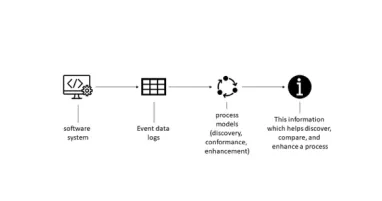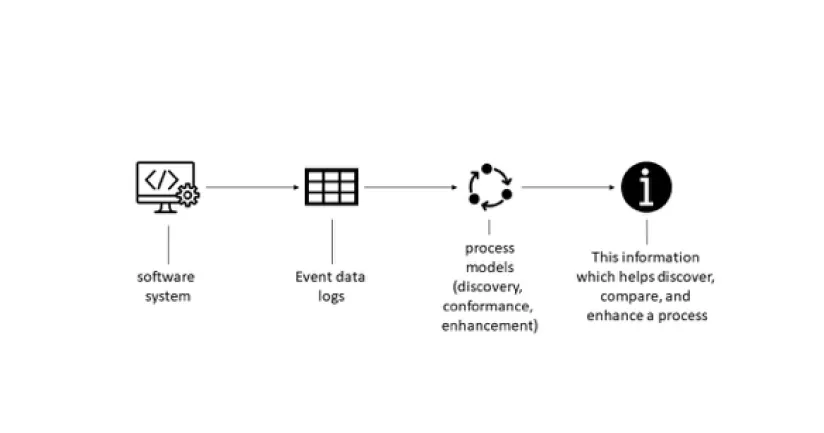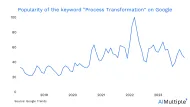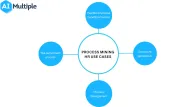Process Mining Architecture, Attributes & Components in '24


Process mining techniques are applied to various sectors ranging from HR to logistics. It enables businesses to identify bottlenecks and reduce unnecessary actions by providing data-driven insights. It is estimated that 83% of companies will be adopting process optimization tools in the following years. However, in order to implement process mining, businesses need to understand its architecture (i.e. process mining components and subsystems).
In this article, we cover how process mining (PM) works and what PM components are.
How does process mining work?
Process Mining (PM) algorithms utilize event logs data that are extracted from information systems and company resource planning systems (e.g., SAP). Event logs refer to the records of the activities in a business together with the timestamps. Such data contain:
- Case id (a unique identifier to recognize the case to which activity belongs)
- Activity description (a textual description of the activity executed)
- Timestamp of the activity execution.
This data is
- visualized in a process flow to present the actual processes.
- analyzed to identify process inefficiencies
Explore how process mining can automatically discover, visualize, predict and assess process performance by utilizing machine learning.
What are the top process mining attributes?
Especially in non-academic material on process mining, the terms attributes, components and techniques are being used interchangeably.
There are three primary components of process mining:
Process discovery
Process discovery aims to transform the event log into a process model. There are numerous techniques to automatically construct and discover process models, such as:
- Alpha algorithm which provides insights about correlations and dependencies between events
- Heuristic miner algorithm which displays visualizations of event frequencies.
As a result of process discovery, as-is processes are identified. To discover how process mining leverages machine learning algorithms to discover processes and design models, feel free to check out common 5 algorithms we explained in detail.
Conformance checking
Conformance checking compares an event log with an existing process model to detect the differences between them. The conformance checking can be managed manually or with the aid of a discovery algorithm. It may also be used to identify deviations, evaluate the discovery algorithms, or simply empower the existing process model. In conformance checking, classical data mining is employed to see the influential variables over the results. Each choice in the process requires a classification model for analysis.
Conformance checking steps include:
- Analyzing the data of non-conformant cases
- Identifying the root causes
For example, a process model may indicate that purchase orders of more than 1 million euros require two checks.
Performance analysis
In cases where there is an existing process model, performance analysis (also known as enhancement) can be implemented. The primary goal is to improve the performance of the existing model based on process performance measures. The model extends with additional performance information such as processing times, cycle times, waiting times, costs, decision rules and organizational information.
Performance analysis steps contains:
- Identifying process bottlenecks
- Suggesting improvements

What are process mining features?
Additional features that can be incorporated into the process mining architecture can include:
Digital Twin of an Organization
Digital twins are the digital replicas of the tools, people, processes, and systems. This technology can be applied to business data to create simulations which are called as digital twin of an organization (DTO). DTOs are designed with the aim to help businesses make model-driven decisions and run cost-effective simulations. To discover more how process mining and digital twins can be paired, feel free to read our complete guide.
DTO is an emerging topic and our process mining enterprise interviews revealed that most companies do not yet rely on DTOs.
Predictive Analytics
Predictive analytics generate prediction model by using insights obtained from process data and it can provide recommendations based on patterns identified in the historical data.
Predictive analytics is a buzzword which stands for leading edge analytics capabilities. As you probably know, even simple analytics techniques like linear regressions can predict future values. Predictive analytics tools are expected to include more advanced techniques like machine learning in their predictions. Read more on predictive process mining and top 3 use cases.
Further Reading
To grasp more details on how AI improves process mining architecture and expected trends in process mining market, check out our articles on:
And if you believe your business will benefit from a process mining, scroll down our data-driven lists of vendors.
Check out comprehensive and constantly updated list of process mining case studies to understand process mining architecture with real-life examples.
And, let us help you the right vendor:
External Links
- 1. “Process Mining.” IBM. Revisited May 9, 2023.



Comments
Your email address will not be published. All fields are required.